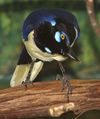Genus Cyanocorax
Purplish-backed Jay - A Purplish-backed Jay eating at the Henry Doorly Zoo
Azure Jay - It has a total length of approximately 40 cm, and its plumage is intensely blue with a contrasting black head and upper chest. Males and females are similar, although the females typically are smaller.
Cayenne Jay - The Cayenne Jay is a species of bird in the Corvidae family. It is found in Brazil, French Guiana, Guyana, Suriname, and Venezuela. Its natural habitats are subtropical or tropical moist lowland forests, subtropical or tropical dry shrubland, and heavily degraded former forest.
Plush-crested Jay - This is an elegant medium sized bird, dark plumaged with a cream-yellow breast; the bulky tail is also cream colored, top and underneath, for the lower half.
Curl-crested Jay - This New World or "blue" jay is a beautiful and large bird with predominantly dark blue back, an almost black head and neck, and snow-white chest and underparts. They have a pronounced curled crest rising from just behind the beak; the crest is on average larger in males, but the sexes are generally quite similar.
White-naped Jay - Its natural habitats are subtropical or tropical dry forests and subtropical or tropical moist lowland forests.
Tufted Jay - It is resident in relatively moist, epiphyte-laden subtropical montane forests, especially those with a large component of oaks.
Azure-naped Jay - The Azure-naped Jay is a species of bird in the Corvidae family. It is found in Brazil, Colombia, and Venezuela. Its natural habitats are subtropical or tropical moist lowland forests and subtropical or tropical dry shrubland.
Brown Jay - It occurs from Mexico south into Central America on the Gulf slope. The northernmost extent of the bird is on the Rio Grande in southern Texas, the lower region of the river called the Rio Grande Valley, .
San Blas Jay - Its natural habitat is subtropical or tropical dry forests.
Violaceous Jay - It is found in Bolivia, Brazil, Colombia, Ecuador, Guyana, Peru, and Venezuela. Its natural habitats are subtropical or tropical moist lowland forests and heavily degraded former forest.
Inca jay - Green Jays have feathers of yellowish-white with blue tips on the top of the head, cheeks and nape, though some taxa have more blue than others, and the crown can appear almost entirely white in some South American subspecies. A black bib forms a thick band up to the sides of the head as well as a stripe through the eye line and one above it. The breast and underparts typically are bright to dull yellow, or strongly green-tinged in the far northermost part of its range. The upperparts are rich green. It has large nasal bristles that form a distinct tuft in some subspecies, but are less developed in others. The color of the iris ranges from dark brownish to bright yellow depending on the subspecies.




